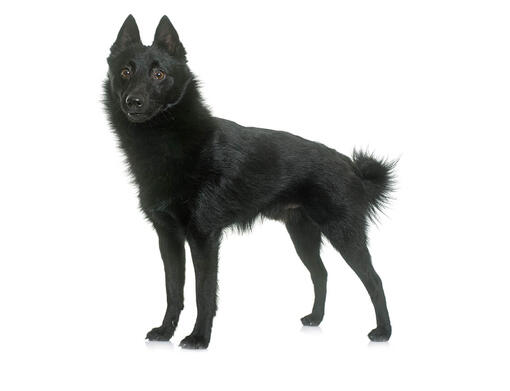
Curious, confident and faithful, the Schipperke originated in the Flemish provinces of Belgium. Protective of family and property, the breed is an excellent house dog with a fondness for children. An active breed, the Schipperke benefits from obedience classes and should receive regular exercise. The Schipperke’s harsh coat sheds several times a year but needs only weekly brushing and an occasional bath.
DID YOU KNOW? Schipperke is Flemish for “little captain.”
The need-to-know
- Dog suitable for non-experienced owners
- Basic training required
- Enjoys active walks
- Enjoys walking one to two hours a day
- Small dog
- Some drool
- Requires grooming once a week
- Non hypoallergenic breed
- Very vocal dog
- Guard dog. Barks and alerts
- May require training to live with other pets
- May require training to live with kids
Personality

Clever and lively, the Schipperke is said by both breeders and owners to be quick to learn, but also quick to get into trouble! Good-natured and generally amenable, they do like to bark to let their family know about anything they deem suspicious or unusual. As such, good dog socialisation and habituation should help ensure they don’t find too many things suspicious or unusual!
History and Origins

The Schipperke was originally a barge dog - small enough to live in the tiny space inside a barge cabin but loud enough to make thieves think twice. They were also well equipped to cope with any weather and able to keep barges and their cargo free of rats and mice. Their origins are a little unclear. Some suggest that the Schipperke is a descendent of the now extinct Belgian Shepherd type, the ‘Leuvenaar’ however unlike this breed, they have a distinctly spitz-like appearance. It is however possible their small size was achieved by crossing the Leuvenaar with the small spitz types from surrounding areas - probably the small German Spitz and Pomeranian. Regardless of their true origins, it is known that the Schipperke dates back to at least the 17th century, as they were first exhibited at the Grand Palace of Brussels in 1690, however they were not given a breed standard until the late 1800’s.
Nutrition and Feeding

Small dog breeds, such as the Schipperke, have a fast metabolism, meaning they burn energy at a high rate, although their small stomachs mean that they must eat little and often. Small-breed foods are specifically designed with appropriate levels of key nutrients and smaller kibble sizes to suit smaller mouths. This also encourages chewing and improves digestion. Discover more about how to offer your dog a balanced diet with our easy-to-follow guide.
Exercise

The Schipperke needs between half an hour to an hour of daily dog exercise as a minimum, and varied, interesting exercise at that. This is a dog with an active mind so do not be fooled by the small size - their origins are as a hardy working breed so skimping on mental and physical exercise will not go down well! A good variety of walking routes is essential as the Schipperke living on a barge would have a new section of towpath to investigate every day and they retain this enjoyment of novelty!
Other Information

Health and common issues
The Schipperke dog is generally quite a hardy breed, but they can suffer some inherited neurological conditions, and hip disorders. For the most up to date health information visit the Kennel Club website or consult the breed club.
Space requirements
Bred to live happily in a very small space within a barge cabin, the Schipperke is not hard to house in that respect. A securely fenced garden is a must however as the Schipperke is agile, fast and has a desire to hunt out small squeaky prey. Whilst they can live pretty much anywhere, consideration must be paid to the amount these little dogs can and will bark. As their tendency is to alert to the comings and goings of the environment around them, think twice about keeping one in a busy environment with close neighbours.
Training schipperke dogs
The devil makes work for idle paws, or so the saying goes in dog circles and that is never truer than with the Schipperke. This little canine will enjoy dog training as long as the right motivation is there and so train with food and toys and keep things fun and interesting. Socialise and habituate well to other animals, children and day to day activity from an early age. Attention must be paid to recall and training a ‘quiet’ cue as the Schipperke loves the sound of their own voice and delights in sharing it with the neighbourhood!
Best family dog breeds
A fun family dog in the right home, you will need time to dedicate to training and keeping the Schipperke’s mind occupied, which may mean they are better homed with older children or teenagers. While many dogs are traditionally thought of as being good with children, all dogs and children need to be taught to get on with each other and be safe together. Even so, dogs and young children should never be left alone together and adults should supervise all interactions between them.
Did you know?
The breed was made popular as a companion and pet by Queen Marie-Henriette (wife of King Leopold II and first cousin to the then future Queen Mary of England). In 1885 she bought a Schipperke she’d seen at a show in Brussels, named him ‘Black’ after his colouring and was often seen walking and driving with him. They became so desirable as a result that some unscrupulous sellers would try to pass off any suitably sized black dog as a Schipperke.